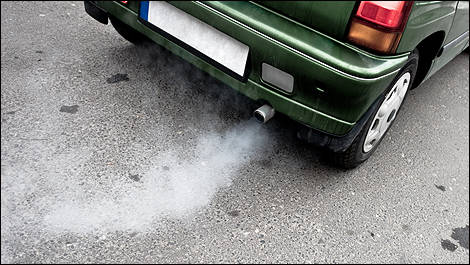No, officer, I swear my car isn’t dying a gruesome death, it’s this new James Bond technology! See, to lose my pursuers, I just press firmly down on the gas pedal here, and a thick cloud of smoke envelops the car behind me. It’s like a secret agent car!
In truth, if 007’s latest sleek machine were to exhibit this symptom, he’d be going nowhere fast.
The telltale puff of smoke that emanates from the tailpipe of the unfortunate vehicles that are way past their due date can point to various problems. To get a better idea of what’s ailing your mature vehicle, the best thing to do is have a friend follow from behind and give you the skinny on the smoke.
The first thing to notice is the colour. Is your baby coughing up white tendrils or blue? Those are two different problems that both require an examination of the cylinder block. Now, what does it smell like? Trust me, the people following you can definitely tell. The smell of burnt oil usually accompanies blue or black smoke. Who hasn’t driven behind a Tercel wheezing out oil as fast as it’s poor owner can feed it?
You’re one of those owners who always check her oil level and keep it topped up? In these cases, the culprit is often faulty piston rings and/or valve cover gaskets. What happens is that oil is burned during fuel combustion. Maintain the appropriate level of oil, and you can keep polluting for years to come!
Does your cabin smell faintly sweet? I suggest making friends with a mechanic as soon as possible. You’re dealing with a coolant leak directly in the cylinder block.
The clever ones will try using a radiator repair agent sold in stores, a thick liquid that contains copper or aluminum particles. Don’t fall into that trap. There’s no better way to kill a sickly cooling system. And trust me, I speak from experience.
Unfortunately, what you need at this point is a head gasket. It’s neither an easy nor difficult job, but it is costly because it directly involves the engine. You’re looking at $400 to $500 for a modest four-cylinder engine and a patient technician. That’s where your newfound mechanic buddy comes in. But don’t go plead poverty and shrug it off. It’s important.
Are you reduced to trying to decipher your car’s smoke signals? There’s no point in trading in an old, oft-repaired model for another one whose maintenance history is unknown. Is your car in good condition? The chassis can survive a tsunami (so to speak)? Then you can consider having the engine fixed.
Your dealer will tell you to start thinking about buying a new car. Here’s my advice: make an honest assessment of the repairs that are needed so you can make an educated decision.
In truth, if 007’s latest sleek machine were to exhibit this symptom, he’d be going nowhere fast.
The telltale puff of smoke that emanates from the tailpipe of the unfortunate vehicles that are way past their due date can point to various problems. To get a better idea of what’s ailing your mature vehicle, the best thing to do is have a friend follow from behind and give you the skinny on the smoke.
 |
The first thing to notice is the colour. Is your baby coughing up white tendrils or blue? Those are two different problems that both require an examination of the cylinder block. Now, what does it smell like? Trust me, the people following you can definitely tell. The smell of burnt oil usually accompanies blue or black smoke. Who hasn’t driven behind a Tercel wheezing out oil as fast as it’s poor owner can feed it?
You’re one of those owners who always check her oil level and keep it topped up? In these cases, the culprit is often faulty piston rings and/or valve cover gaskets. What happens is that oil is burned during fuel combustion. Maintain the appropriate level of oil, and you can keep polluting for years to come!
Does your cabin smell faintly sweet? I suggest making friends with a mechanic as soon as possible. You’re dealing with a coolant leak directly in the cylinder block.
The clever ones will try using a radiator repair agent sold in stores, a thick liquid that contains copper or aluminum particles. Don’t fall into that trap. There’s no better way to kill a sickly cooling system. And trust me, I speak from experience.
Unfortunately, what you need at this point is a head gasket. It’s neither an easy nor difficult job, but it is costly because it directly involves the engine. You’re looking at $400 to $500 for a modest four-cylinder engine and a patient technician. That’s where your newfound mechanic buddy comes in. But don’t go plead poverty and shrug it off. It’s important.
Are you reduced to trying to decipher your car’s smoke signals? There’s no point in trading in an old, oft-repaired model for another one whose maintenance history is unknown. Is your car in good condition? The chassis can survive a tsunami (so to speak)? Then you can consider having the engine fixed.
Your dealer will tell you to start thinking about buying a new car. Here’s my advice: make an honest assessment of the repairs that are needed so you can make an educated decision.


